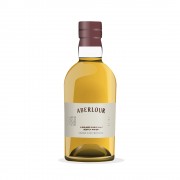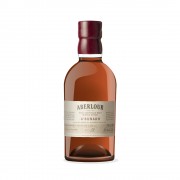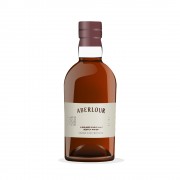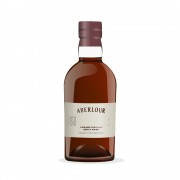Aberlour 15 Year Old Double Cask Matured
Sour Cranberry to Graham
0 081
 Review by @vanPelt
Review by @vanPelt
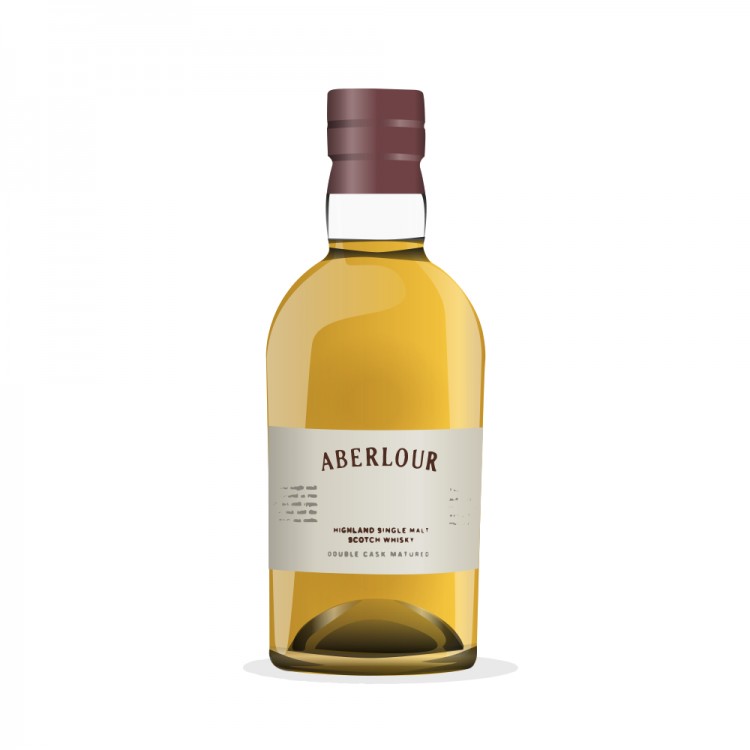
- Nose~
- Taste~
- Finish~
- Balance~
- Overall81
Show rating data charts
Distribution of ratings for this:
I’ve now sufficiently analyzed this malt, enough to be worthy of at least a few separate reviews. But I’ve distilled it all here. Why the deep analysis? 2 basic reasons: Wanting to make up for a shortage findable of reviews on the internet; and wanting to make the best of an initially disappointing purchase. All for the benefit of you, the reader and prospective buyer! I'll simplify by splitting this into “chapter" summaries:
(1) Background of purchase (2) Sorry…, but I’m disappointed in other Connosr members. (3) Tasting notes (the main section). Official tasting notes are misleading. (4) Assessment and Recommendations for enjoying (5) Aberlour: Praises and suggestions for marketing
1
This 15yo Double Cask is currently one of the 6 “core” Aberlours, according to their website. (The others are 12yo DC, 16yo DC, 18yo DC, 12yo Sherry, and the A'bunadh.)
I bought this bottle because of : (a) A high score on Connosr, (b) tantalizing bottle tasting notes, and (c) trust in the distillery (and the temptation of having their "exclusive"). I've previously had and reviewed Aberlour's 10yo, 18yo, and 2 batches of the A'bunadh; I was impressed with all of them. So I'd been eyeing this 15yo for a couple years, figuring it should be just 17% shy of the 18yo. (And Glenfarclas has a great 15yo, so why not Aberlour?) So I finally made the purchase when I saw a discount at Duty Free.
2
Here's the situation: This malt has occupied 22 Connosr cabinets, over some years-- and yet, sadly, nobody else has yet written a review. Of these 22, 7 have generously assigned cabinet ratings, yielding an average score of 91(wow!). This rating encouraged my purchase, despite the lack of reviews. But come on Connosrs! Pick up the pen! You can at least make a note to quickly explain why you liked it.
Okay, I’m done grousing. :)
3
Tasting notes. First consider the notes on the packaging: Malt, Toffee, Honey, Vanilla, Coconut. (Ooh lala!)
Okay, now from the Aberlour website: Flowery, Grassy, Grapefruit (nose), Creamy, Sherry, Nutty, Orange, Toffee, Smoky, Buttery. (Plus: Sweet, Rounded, Thick, Velvety, Balance.) (Sounds enticing!)
So now, here are my notes:
EVOLUTION: This is VERY important. The fresh bottle is very muted and mellow (and likable). But within a mere 2-4 days (3 drams), the bottle immediately oxidizes and enters “The Sour Period”. (I have never before experienced a malt transforming so quickly.) It remains sour for a couple months, and then by around 2 months (1/2 bottle) it starts improving.
Fresh bottle (A Rocky Road): Score 78 Nose: Sneakers, marshmallow, milk chocolate. Getting some faint cranberry. Palate: Citric toffee entrance mellows to vanilla cocoa, to graham and coffee grounds, with sour-cherry and lemon emerging. Finish: Same as palate but lighter. Short. Overall: Muted and low-impact, but promising.
Subsequent 2 months (Sour Cranberry): Score 68 Nose: Very apparent now, and very good. S’mores or shortbread at full vapor. Then dominant cranberry (or sour cherry juice and fresh bitter almond slivers). (Longer breathing settles to lemon cream.) Palate: Lemony (bitter-sour) cereal entrance cloaks underlying vanilla. So far okay... but then becomes substantial sour cranberry and bitter almond, and grassy. Acid (also at the back of the throat) continues into the finish. Finish: Acidic. Drying cranberry effect and grass; a whole organic lemon. Some smooth vanilla only if the acid is not burning too much. Overall: This is really all about cranberry, in any form.
After 2-3 months (Cranberry Graham): Score 82 Nose1: Initial vapor of acidic grassy cranberry happily dissipates, into… Nose2: Honey-malty vanilla and cocoa, with some sneakers and lemon zest. Palate: Enters as soft thin lemon and honey-malty vanilla. Joined by some toasted coconut and grassy sour-cherry. The palate peaks with malt graham in the throat and vague cranberry on the tongue. Much smoother (less acidic) now into the finish, with pervading vanilla. Finish: Cranberry, graham, and coconut marshmallow vie for attention in the throat and on the tongue. Acidic tones felt more to back, vanilla more to the front. Overall: Quite okay, much less sour and admittedly closer to the bottle’s tasting notes. But this took too long, and I thinking I should wait longer still.
This was my first relative disappointment from this distillery. For almost the same price, I could have gained an A'bunadh. Maybe I can be more sensitive to sourness than other reviewers, but I'm not over-exaggerating the Sour Period. The burn in the back of the throat and mouth remind me of much younger days..., of taking shots with much lower quality spirits. Luckily the malt has now improved, almost to average single malt quality. I do wish the malt exhibited more of the anticipated sherry influence, however. I still remain curious about the experiences of others. How could 7 Connosr ratings average 91?
4
My interpretation is that the quickly formed sour contents need to “evaporate off”, in order to leave behind a more oak-influenced maltiness. I am no expert in maturations or mixing, but it seems to me that this is an unsuccessful double-casking marriage, with a weak sherry fruit influence that just doesn’t want to hold. The distilleries don’t need to disclose the proportion of casks, but I guess this is very far from 50-50, i.e. the sherry is too diluted to maintain a robust balance— and perhaps it is the diluted flavors that actually cause problems in the first place. I don’t know. But I do find myself disappointed again and again with double casked malts. In contrast, though, I would guess the 18yo is predominantly sherry.
I have attempted several experiments to improve the malt, especially in the Sour Period. To summarize quickly:
(A) The most effective improvement method is consistent with the above-stated “evaporate off” theory. After pouring a dram, place the glass on a hot stove for a minute or two, in order to heat the malt, at least to body temperature. (You can also just leave it at room temperature for more than an hour— or a couple months….) Somehow the acidity lessens or even disappears! Do NOT try the opposite and add ice! I have tried this, and the acidity really worsens, even though the spirit gets diluted. Cold Bad; Heat Good.
(B) You can add water, bringing the alcohol content around 37%. This is not as effective as heating, but it does lessen the sourness and turns it more to thin caramel. You have to be really careful not to make it too watery, e.g. 35%.
(C) Pay attention to how you drink. Big gulps will really burn the throat, so take small sips. Letting the liquid settle around and under the tongue will accentuate the bitter-sour sensations, so keep it swishing on top to maintain the better entrance flavors.
Of course, you could imagine some other tricks to improve this, such as adding maple syrup etc. I did not resort to these, since time started to improve the malt.
5
Aberlour: The distillery's customer service responded excellently, when I inquired whether I had an especially poor bottle. I received a sample of an older batch, for comparison, and I subjected it to the same careful scrutiny. The experience and malt evolution was similar, unfortunately. But the service representatives maintained good communication.
Despite this, I do have a couple other comments for Aberlour. Firstly, shame for not writing the ABV on the packaging (or the retailer's unit price information). You have to open up the packaging to see “40%” in the fine print, on the bottle itself. And of course, secondly, I am very skeptical about how the tasting notes were prepared, as I’d mentioned.
On the plus side, Aberlour did send me the tasting notes of the Master Distiller. I find these to be closer to reality: Dry, Raisin, Spicy, Nutty, Oaky, Floral, Autumn Fruits. Indeed, "Autumn Fruits" do comprise Cranberry, Pomegranate, and Quince— which more accurately describe the experience.
Duty Free: Finally, I feel I'd become a bit of a sucker for Duty Free "Exclusives". I'd had very good experiences the first couple of times (they were both Bowmores), but my last 5 or 6 Duty Free malts have all left me feeling let-down. The best solution would be for other Connosrs to share more often their experiences with Duty Free Exclusives. It is the only practical check we have, as consumers.
If you have scrolled down for a summary, here it is: - This malt changes to sour very quickly after opening the bottle. - The bottle eventually improves over several months: otherwise a dram can be improved by warming. - Official tasting notes are poor, but I still appreciate Aberlour and their other products. - If you're going to bother putting a whisky in your online cabinet, please take the extra minute when rating, to just say what you did or did not like!
